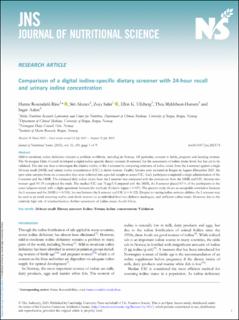| dc.contributor.author | Rosendahl-Riise, Hanne | |
| dc.contributor.author | Aksnes, Siri Yde | |
| dc.contributor.author | Sabir, Zoya | |
| dc.contributor.author | Ulleberg, Ellen Kathrine | |
| dc.contributor.author | Myklebust-Hansen, Thea | |
| dc.contributor.author | Aakre, Inger | |
| dc.date.accessioned | 2023-12-08T12:42:36Z | |
| dc.date.available | 2023-12-08T12:42:36Z | |
| dc.date.created | 2023-10-10T12:42:58Z | |
| dc.date.issued | 2023 | |
| dc.identifier.issn | 2048-6790 | |
| dc.identifier.uri | https://hdl.handle.net/11250/3106633 | |
| dc.description.abstract | Mild-to-moderate iodine deficiency remains a problem worldwide, including in Norway. Of particular, concern is fertile, pregnant and lactating women. The Norwegian Dairy Council developed a digital iodine-specific dietary screener (I-screener) for the assessment of iodine intake levels but has yet to be validated. The aim was thus to investigate the relative validity of the I-screener by comparing estimates of iodine intake from the I-screener against a single 24-hour recall (24HR) and urinary iodine concentration (UIC) in fertile women. Healthy females were recruited in Bergen in August–December 2021. Six spot-urine samples from six consecutive days were collected into a pooled sample to assess UIC. Each participant completed a single administration of the I-screener and the 24HR. The estimated daily iodine intake from the I-screener was compared with the estimations from the 24HR and UIC. Seventy-two women aged 19–39 completed the study. The median UIC was 76 μg/l. Compared with the 24HR, the I-screener placed 83 % of the participants in the same/adjacent tertial, with a slight agreement between the methods (Cohen's kappa = 0⋅187). The present study shows an acceptable correlation between the I-screener and the 24HR (r = 0⋅318), but not between the I-screener and UIC (r = 0⋅122). Despite its varying iodine estimate abilities, the I-screener may be used as an initial screening tool to rank fertile women on an individual level into deficient inadequate, and sufficient iodine intake. However, due to the relatively high risk of misclassification, further assessment of iodine status should follow. | en_US |
| dc.language.iso | eng | en_US |
| dc.publisher | Cambridge University Press | en_US |
| dc.rights | Navngivelse 4.0 Internasjonal | * |
| dc.rights.uri | http://creativecommons.org/licenses/by/4.0/deed.no | * |
| dc.title | Comparison of a digital iodine-specific dietary screener with 24-hour recall and urinary iodine concentration | en_US |
| dc.type | Journal article | en_US |
| dc.type | Peer reviewed | en_US |
| dc.description.version | publishedVersion | en_US |
| dc.rights.holder | Copyright 2023 The Author(s) | en_US |
| dc.source.articlenumber | e90 | en_US |
| cristin.ispublished | true | |
| cristin.fulltext | original | |
| cristin.qualitycode | 1 | |
| dc.identifier.doi | 10.1017/jns.2023.74 | |
| dc.identifier.cristin | 2183321 | |
| dc.source.journal | Journal of Nutritional Science (JNS) | en_US |
| dc.identifier.citation | Journal of Nutritional Science (JNS). 2023, 12, e90. | en_US |
| dc.source.volume | 12 | en_US |

